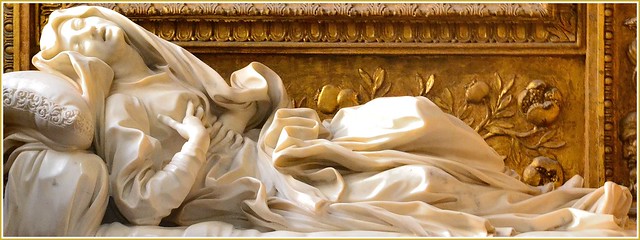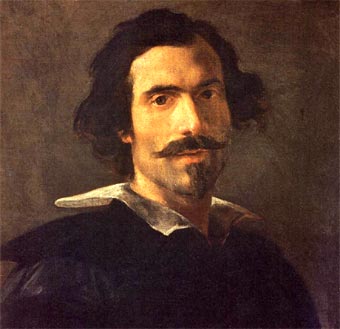This famous sculpture was made in Rome, and Bernini
started making it in 1671 and finished it in 1674. The sculpture was
commissioned by the Church of San Francesco a Ripa in Rome. Then, it was placed
in the left part of the church, in the Altieri Chapel.
This is a sculpture made with only one material:
marble. It represents Ludovica Albertoni, a roman noblewoman who lived a pious
life, and who worked to the poor of Tratesvere neighborhood under the San
Francesco Church, where she was buried in 1533. This woman is represented on a
mattress in the moment of mystical communion with God, that’s because he’s got
her hand in her chest and that exhausted face. She’s represented with clothes
similar to nun’s. This sculpture is so realistic: the face of Ludovica shows an
state of ecstasy because her soul is gathering with God. In his sculpture, concentrates a lot of light. Bernini thought
in everything: he designed an architectural setting that focuses attention and
light in the sculpture. There is a painting behind the sculpture painted by
Baciccio.

Source: https://www.flickr.com/photos/te_whiu/6120984019/
As is a Baroque sculpture, we observate the following
features:
- · The sculpture represent movement: it represents the movement of Ludovica Albertoni while she’s reuniting her soul with God.
- · The sculpture cause a sensation of emotion because it represent a fleeting moment: it’s a very unsual position because the movement is due to divine nature, and for that it causes us emotion.
- · We can observate curved lines over all the sculpture but above all in the Ludovica Albertoni’s clothes.
- · The sensation of movement in the sculpture is intensify by cloth folds over all the sculpture. They are recognized easily, for that we have a big sensation of movement when we see at first sight the sculpture.
Source: http://en.wikipedia.org/wiki/Blessed_Ludovica_Albertoni
There is another interesting information about the
sculpture:
Bernini lasted so much in finishing this famous
sculpture, from 1671 to 1674. Three years. This was due because he concentrated
the majority of his work in other two works: The Tomb of Pope Alexander VII and
The Altar of the Blessed Sacrament in St. Peter’s Basilica.
Here there is a portrait of Bernini:

Sources: http://www.biografiasyvidas.com/biografia/b/bernini.htm
Other sources used: http://en.wikipedia.org/wiki/Blessed_Ludovica_Albertoni
http://www.italianways.com/the-ecstasy-of-blessed-ludovica-albertoni/
.jpg)
1 comment:
Hello Alfredo,
Here you have my corrections and your mark. Erase the words in brackets:
-... represents Ludovica Albertoni, a Roman noblewoman who lived a pious life, and who worked for the poor of Trastevere neighborhood under the San Francesco Church,
- ...with clothes similar to nuns. This sculpture is very realistic: the face of Ludovica shows a state of ecstasy because her soul is gathering with God. In his sculpture, (concentrates) a lot of light is concentrated.
-...As it’s a Baroque sculpture, we observe the following features:
-...The sculpture represents movement:
- The sculpture causes a sensation of emotion because it represents a fleeting moment: it’s a very unusual position because the movement is due to divine nature, and for that reason it causes us emotion.
-... We can observe curved lines over all the sculpture but above all in (the) Ludovica Albertoni’s clothes.
-... The sensation of movement in the sculpture is intensified by cloth folds over all the sculpture. They are recognized easily, for that reason/ that’s whywe have a big sensation of movement when we see the sculpture at first sight
- There is another interestingpiece of information
- Bernini took a lot of time to finish this famous sculpture, from 1671 to 1674. Three years. This was (due) because
I think you could have done it better, comparing it with other Bernini's works, like Ecstasy of Saint Theresa.
Your mark is 8. Bye.
Post a Comment